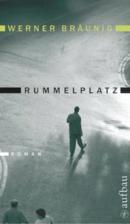
by Werner Bräunig
The setting is pretty interesting from a historical perspective. When the Americans dropped the nuclear bombs in Japan the Russians needed desperately and and very quick Uranium. The solution was to exploit the deposits in the Russian sector of post-war Germany. They founded a Russian owned company called euphemistically “Wismut”. The situation after the war: hunger, most Germans without bearing and missing male labour everywhere. To get the workforce into these dangerous mines, they sent convicted criminals, or tried to persuade with very high wages. That created a very special state in the state with its own laws. The author tries to depict what moved the German after the war in this focal point. If you want to know, how the phenomena East Germany started, read this book.
Nevertheless, equally interesting are the circumstances of the publication of the work. Bräuning wrote it in the early sixties. It was planned to show the progress in life of several key people in East and West Germany. Bräuning himself had a troubled youth after the war and found a fix point in writing and socialism. He had chosen that suspicious setting because he knew it from first hand, and from the darkness he could develop his characters to the “bright future” in socialism. The irony is that the communist government at that point in time wanted to teach and give directions what the “real” culture is and picked this novel to show the iron fist of censorship. It wasn’t even published yet but the first draft versions circulated already. The criticism was so devastating that Bräuning desisted from the project . From then on he only published small pieces and fell into alcoholism, from he died in 1976. Miraculously the manuscript survived in some archive and was displayed in a historical exhibition after the fall of the Berlin wall in 1989. Bräuning’s children got to know about it and managed to get it back. After a meticulous work on various versions it was finally published in 2006. What a revelation! Some think he could have been one of the great post -war writers in Germany.
Anyway it is worth to be read – at least if you are interested in the beginnings of the german “Democratic” Republic and it’s dreams it was based on.
Nevertheless, equally interesting are the circumstances of the publication of the work. Bräuning wrote it in the early sixties. It was planned to show the progress in life of several key people in East and West Germany. Bräuning himself had a troubled youth after the war and found a fix point in writing and socialism. He had chosen that suspicious setting because he knew it from first hand, and from the darkness he could develop his characters to the “bright future” in socialism. The irony is that the communist government at that point in time wanted to teach and give directions what the “real” culture is and picked this novel to show the iron fist of censorship. It wasn’t even published yet but the first draft versions circulated already. The criticism was so devastating that Bräuning desisted from the project . From then on he only published small pieces and fell into alcoholism, from he died in 1976. Miraculously the manuscript survived in some archive and was displayed in a historical exhibition after the fall of the Berlin wall in 1989. Bräuning’s children got to know about it and managed to get it back. After a meticulous work on various versions it was finally published in 2006. What a revelation! Some think he could have been one of the great post -war writers in Germany.
Anyway it is worth to be read – at least if you are interested in the beginnings of the german “Democratic” Republic and it’s dreams it was based on.
Facts:
English title: n/a
Original title: Rummelplatz
Published: 2006
